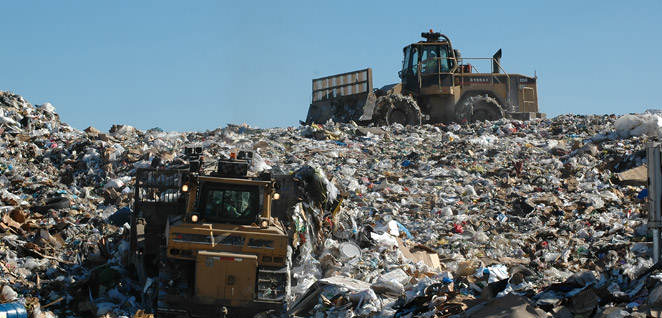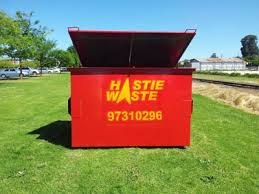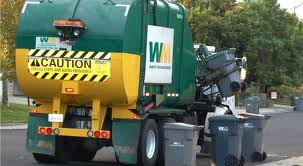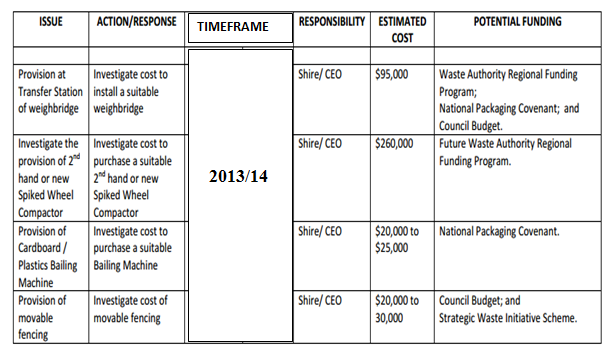Executive summary
The concept of waste management continues to boost environmental efforts throughout the world. Many countries realize that certain categories of waste contain a utilitarian value. Waste that may be toxic should be disposed of appropriately to avoid causing harm to humans, the environment, and animals. Waste management efforts cannot succeed without suitable policies and goodwill from the state. Australia is a country that succeeds in waste management and this paper focuses on a case study based in the area of Collie. The plan on waste management for the city of Collie enables governments and donors to appreciate the concept of waste management. The approach, however, requires a strategic approach. The Shire of Collie demonstrates that waste management can accrue profits to local authorities as recycled materials can be sold to industries.
A proper waste management plan can bring profits through service charges. The Shire of Collie develops its waste management plan in accordance with the Waste Management Organization Board of Western Australia. The city has a zero waste development plan that advocates for intolerance to the existence of waste in different parts of the region. The approach provides necessary guidelines on the current situation of waste management in the Shire of Collie. It also incorporates strategies that may be used to combat and redirect the situation towards an efficient future. Australia seeks to be one of the regions across the world with a competitive waste management scheme and policy. Most of the regions within the proximity of the Shire of Collie undertake drastic measures to control the growth of the waste management problem. In addition, local governments receive significant amounts of money to work in association with other authorities in efforts to control and manage waste (Conner, 2011).
This case study explores diverse findings and recommendations from this project of waste management. Waste management sites may be ignored due to their low value. However, the traditional dimension treats waste management an unimportant field. However, with the advent of massive appreciation for the environment and the culture of sustainable development, this assessment recognises a substantial shift from this view. For instance, recycling and resource recovery is consequential, and one of the most appreciated cultures across the globe.
Historically, all waste was dumped recklessly in undesignated sites to be either buried or burned by relevant authorities, but this practice is no longer acceptable. This plan recognises recycling and resource recovery as remarkable alternatives. Continued public education may bring further improvements to the approaches. The Shire of Collie remains proactive on its waste management procedures. The area was the first within the South West Group to take action on waste control. In 1997, the city developed and controlled a waste management transfer centre. The authorities did not previously control the facility. Today, the dumping ground continues to undergo development efforts. The governance of the Shire of Collie has embarked on a mission to reprocess oils and different types of metals. The Shire of Collie considers procuring a wood chipper that can be used for mulching green waste materials. This aspect may work better than the system that has been in operation over the past 8 to 9 years. The wood chipper can be a manifestation of the shift from a dumping ground to a reprocessed utility. At the moment, the town contains only a single certified dumpsite called the Gibbs Road Site. The strategic draft for the management of debris should be aligned with that of the authorities of the Shire of Collie. The strategic procedures must derive a lot of guidance from environmental and local government policies.
Facility’s description
The Shire of Collie is one of the local government areas in Australia. The region is about 60 kilometres in length. The town lies in the south western side of Canberra. The region falls within the inland of the Darling Ranges. Residents sometimes refer to these ranges as the Collie River Valley. The Shire zone covers an area of approximately 1,712 square kilometres or 661 square miles. The government gazetted it in 1901, as a separate municipal district to accomplish the affairs of the town of Collie.

Background information on location and types of facilities
The Collie economy mostly depends on industrial activities. The region contains heavy commercial industries that range from Wesfarmers and Griffin Coal mining projects and the Worsley Alumina Bauxite mining and processing resource (Catherine et al 2008). This aspect implies that the city is likely to produce high amounts of waste products. A team of government and private experts manages the factories. Most of the industries produce light, industrial based chemicals. Harris Dam is the main source of clean water. The Wellington Dam also provides water to the city of Collie. The two are the major water supply resources for the Shire of Collie (Environmental Protection Agency 2013).
Demographic data
The Shire of Collie comprises of various zones. These areas contain different population sizes. The regions include the Mungalup Road Settlement located approximately 6 kilometres from the site. Preston Road Zone features approximately 11 kilometres from the area. The Worsley area is relatively smaller in the area as opposed to other zones. In addition, the Allanson Estate features about 7 kilometres from the region (Australian Bureau of Statistics, 2006).
Population and related projections

The Shire of Collie may realise an increased population growth rate of 2% until 2032. Predicted population projections show declining numbers of people of the Collie region with a negative 0.38% growth rate (Chris 2011). This aspect predicts a reduced population for the region by the year 2030 (Australian Bureau of Statistics 2013).
Waste management practices
Currently, the Shire of Collie operates an internal waste management program. The region uses a standard “242L MGB” to collect waste for a period of one week. The Australian authorities established the Kerbside Reprocessing Project in 2008. This program related to the collection of waste and management of the issue for all residential estates in the region (Concern World, 2012). Furthermore, reclaiming for economic reasons was also a viable option. The area has a waste management site that stands at “Reserve 36458 Gibbs Road or Coalfields Highway”. The waste management location stands about 2.6 km east of the CBD of Collie. The zone is currently serving as the primary waste management area in the region and comprises of a combined landfill and waste transfer position. The Australian authorities certify the landfill in accordance to the environmental regulations of 1986. The government accords the debris site a dual classification rank in accordance to existing environmental policies. A number of the current waste management practices of the site include a “¾ category 63 site”. It contains a solid waste depot with a design aptitude of 500 tonnes annually. The other classification comprises of the “¾ Category 65 of Class II waste management site” with a production and design volume of 20 tonnes in a year (David 2009).
The council conducts a general practice of garbage transfer that comprises of acceptance, sorting and storage of the waste. The locality also undertakes forms of reprocessing of unique resources. The authorities classify the dangerous and harmful waste materials and other additional waste products. Perilous dump resources include oil products and asbestos. These resources are admissible at the site for processing and further re-utilisation. The government allows the site to operate as an active waste “burial” facility. The authorities operate other activities in the site like landfills, type 2 inert, type 1 and type 2 specialist, putrescible and contaminated solid waste (Henrik & Merete 2012). The debris ground is the only facility administered by the council within the Shire of Collie. It caters for the re-use of construction, demolition and industrial debris.


A number of the projected infrastructural needs for Shire may comprise of a “¾ waste compactor or spike wheeled roller”, a “¾ weighbridge facility” and “¾ rubbish screens or fence” (Government of Western Australia 2008). In addition, this report lays emphasis on the necessity to hire an environment expert to provide consultancy services on proper management of the site. The professional should be paid by the government using grants. The expert should serve Donnybrook and Boddington localities.
Waste management framework

Rationale for waste assessment
The area has identified the natural environment as an important part in the restoration of the environment. The plan emphasises on the importance of promoting environmental protection in the region. This aspect increases the quality of the environment and life. A waste management plan helps in the minimisation of the effect of solid and other types of waste, contributes to the rehabilitation of the degraded Collie River and enhances sustainable environmental efforts in Collie (Land Design Group 2009). The draft promotes the values of sustainable development in commercial and industrial development. Waste management can promote the capacity of industries to reduce carbon emissions to the environment. It helps in the reduction of environmental effects of debris and its future management. Furthermore, it is an appropriate approach of improving community inclusion on the effect of waste on the society.
Methodology
The whole process begins with the identification of the case study and the problem of waste management. This fact helps the researcher to identify and understand the issues underlying the site and to conduct a comprehensive assessment. Literature review relates to the various secondary sources with regard to the waste management site of Collie. The field surveys enhance the activity that the researcher carries out in the study area. After the field survey, the researcher analyses the data for one week and finally presents in different formats.
Primary data involves information that the researcher collects from the field survey. The main sources of this data relate to the city. The researcher derives the secondary data from the literature review. The main sources of this data include documents like books, journals, newspapers, magazines, previous studies on solid waste management and reports, policies, regulations, development plans and laws and by-laws on solid waste management.
The city of Collie’s refuse production
The Shire of Collie does not own a weighbridge amenity. This fact is similar to the majority of rural landfills in Western Australia. However, different studies show that construction and demolition wastes contribute most to the dump sites in the region. In addition, commercial and industrial areas form a remarkable segment of waste generation. Other common wastes in the region include asbestos waste. Motor oils from the automobile industry comprise of other forms of waste generated in Collie.
Waste management legislation
This case study examines several pieces of legislation that govern the management of waste in the region. These statutes include the Waste Avoidance Resource and Recovery Act 2007 (Oeltzschner & Mutz 2011). The regulations only permit local authorities to administer waste management. The legislation modified the concept of waste services of the Health Act of 1911. The Waste Avoidance Resource and Recovery Levy Act 2007 also set the levy for waste that the authorities receive at the metropolitan landfills. This report notes on-going consultations to include large, rural regional sites. The council utilises the taxes imposed on waste management services in accordance to the Waste Authority. The Health Act may be relevant to waste management and environmental conservation because it interprets and acts on policies related to public wellness. The regulatory procedure of 1992 controls matters related to the waste management of asbestos. The other statute that addresses issues that relate to the administration of waste resources in Australia includes the “Environmental Protection Act 1986” which oversees that the waste authorities prioritise environmental conservation efforts.
Analysis of results
The evaluation of the site indicates that the city of Collie conducts its debris management activities independently. The region generates a significant amount of waste in Australia.

The findings indicate that the authorities do not collect the green waste at the kerbside. However, the council receives the debris separately when local and business parties deliver it. This paper affirms that commercial and industrial waste make the biggest contribution to the entire debris collection in the area. This draft observes an increase in interest from private contractors in the waste management industry. These contractors improve the efficiency of waste management and control in the region.
Analyses for waste minimisation opportunities and savings
The plan outlines significant waste minimisation opportunities in the region. The instances of waste minimisation may increase recycling drop- off facilities. The plan evaluates the need to increase recycling bays in the region. The other opportunity involves the survey of re-use facilities in waste management. These components can be installed in different buildings. The other opportunity is to allow for the entry of the public into the waste management industry. This aspect can be a crucial milestone in waste minimisation (National Emissions Trading Taskforce 2010).
The “Landfill Expectancy Model” serves to assess the rationale and the impact of the waste management model. The plan indicates the likelihood of high saving as a result of application of efficient waste management techniques. In order to ascertain the landfill site’s life, the model includes a number of factors, like quantity of cover materials applied, waste density, and compaction rates (Lands and Parks 2008). These factors can be varied to determine their impact on the landfill site process. The introduction of different waste management operational and engineering alternatives ensures that the authorities save the resources in the waste management exercise. The council realises profits from the waste conservation efforts. It uses modern equipments like a garbage compactor. It also uses strategic management programs and expansion plans to make money.
Analyses for costs and benefits
At the present state, the Shire of Collie charges about $83 to households per year for their 27 fortnightly collections of the “1 x 242L MGB” recycling bin (Mark 2011). The approximate number of dwellings or users is about 3,608 and the figure may increase with time (Neufert et al 2010). The amount is about 2.7% of residual waste disposal.
The city of Collie: Kerbside dump management
The local government of Collie administers a waste collection system for its residents. More than half of the standard household bin container for general nonrecyclable waste is a “241L MGB” (Total Environment Centre 2008). The council makes three quarters of its total collection of waste once per week and greater than half of its cost for the MSW. The domestic waste service per household is $166‐00 annually (WALGA 2008).
The authorities include the costs associated with disposal of this waste by residents in the yearly charges per household of $166 ‐ 00 (Coley et al 2007). The entry into the landfill by residents currently incurs no extra charges above the $166 ‐ 00 (Scottish Executive Social Research 2009). The accountants of the council apply economic practices like waste costs to calculate charges on an annual basis. The authorities determine the charges of waste services based on the size of the bins or the actual waste load. They also impose fixed charges for the purposes of maintenance of their vehicles. The deficiency of a weighbridge in the city makes it possible for the authorities to collect garbage and transport it to the site without transportation barriers.
Recommendations for waste minimisation
This plan outlines various recommendations for the minimisation of waste in the Shire of Collie. The area should implement a kerbside recycling program. This aspect is a notable endorsement for the site. Another commendation entails the initiation of a recycling plant. The Kerbside project should improve its capacity to high volumes of recycling. Currently, the authorities collect the recycling bin every fortnight. The yearly cost to rate payers is $82. The draft emphasises on increasing the collection of re-used paper. Re-claimed cardboard should form part of the recyclable resources. The landfill should be fenced. The Collie dump has entered into contracts with authorities in order to provide fencing to the debris ground. The government does not see the need for a fence to control “windblown” debris. This plan recommends the authority to construct a fence to limit access to the debris site. Barricades may be used to prevent illegal entries into the site.
Aims for future waste minimisation practices
The Shire of Collie intends to achieve significant progress towards realising a policy of zero waste. This objective may be in line with the deliberations of the Australian government. A number of the strategic actions for realising these goals include the post closure activities and surveillance at the Gibbs Road Landfill, the progressive work with other South Western Australia local government councils on regionalisation strategies wherever they may be practicable and possible. The aim should be to achieve waste management funding that may meet the required debris management efforts. The draft lays emphasis on the need to have a continuous monitoring and evaluation framework for the dump sites. A number of the practices like waste avoidance should be part of the culture of the area. The local authorities of Collie should create mechanisms for secondary refuse management and educate its residents on ways of reducing waste.
A waste minimisation strategy for the facility
The Shire of Collie needs to adopt a waste minimisation program for the facility. This aspect should include organic processing. This approach may entail enhancing the capacity of the site to reduce biodegradable waste going into the landfill. The other dimension may involve the construction and demolition of waste reuse. This fact may comprise of crushing waste in the area for further assessment. Crushed debris may be utilised for the purpose of covering the local government waste. This point may contribute towards significantly reducing the cost of waste management. The other requirement denotes the transfer of the station and re-use facility.

Actions necessary for implementing the recommendations
Various fundamental actions may be essential for the implementation of the recommendations. A number of the relevant actions include improving the existing services and efficiencies and increasing the efficacy of waste management. Collie may need to work with other Australian local councils. It may become a signatory to waste management agreements among local governments in Australia. It may also hold educative seminars aimed at empowering local councils on ways of improving, processing and managing their garbage collection. The Shire of Collie may serve as a model waste management entity for other councils to emulate.
The capacity of waste management personnel may need enhancement. Human resource needs may include skills, training and professional development. The Australian government recognises the Shire of Collie as an area in which group training of employees from several different local authorities may be done. The area can be essential in providing and improving the economies of scale regarding training and continued professional development. This draft establishes the necessity of establishing an adequate queuing area for vehicles using the facility so that the government does not interrupt the external traffic flows. Other interventions may include preferential access to recycling facilities, emergency vehicles at all times, possibly through an alternative entrance. The authorities need to limit access to the public road network. This idea can reduce vision across the locality for council employees. The administration of the site needs to separate vehicles and pedestrians. Another measure may involve effective traffic control devices and provision of essential infrastructure for the management of waste. The other critical requirement may entail the improvement of public communication. The plan affirms the need for the Shire of Collie as part of its communication strategy, to carry out a public survey using different models. This aspect can improve the public participation objectives achieved as survey returns may be considered substantial in addressing community expectations (Department of Parks and Recreation 2011).
Timeframe for achieving the recommendations

References
Australian Bureau of Statistics 2013, Australia’s Environment: Issues and Trends, 2013.
California Environmental Protection Agency 2013, Compliance Report for the Recycled-Content Newsprint Program, Web.
Catherine et al 2008, “Globalization, Extended Producer Responsibility and the Problem of Discarded Computers in China”, An Exploratory Proposal for Environmental Protection, vol14.no.6 pp. 525- 531.
Chris, W 2011, The Public Value of Urban Parks and Understanding Park and Usership, The Wallace Foundation, New York City.
Coley et al 2007, “Where does Community Grow? The Social Context created by Nature in Urban Public Housing”, Environment and Behaviour, vol. 29 no. 4 pp. 468 –494.
Concern World, 2012, Trash and Tragedy Report: The Impacts of Garbage on Human Rights in Nairobi City, Concern Worldwide, New York.
Conner, N 2011, Some Benefits of Protected Areas for Urban Communities: A view from Sydney Australia, The Urban Imperative, California Institute of Public Affairs, California.
David, A 2009, Metric Handbook Planning and Design Data, Architectural Press, Oxford.
Department of Parks and Recreation 2011, Park Design Guidelines, California Institute of Public Affairs, City of Sacramento.
Government of Western Australia 2008, Extended Producer Responsibility Policy Statement, Australia Government Printers, Sydney.
Henrik, J & Merete, K 2012, Case studies on Waste Minimisation Practices in Europe, Web.
Land Design Group 2009, Design Review and Neighbourhood Park Guidelines, Carbson City, Nevada Tech Publishers, Nevada.
Lands and Parks 2008, Park design guidelines & data: A natural landscape architecture for British and Columbia’s Provincial Parks, Institute of BC Parks, London.
Mark, M 2011, Media statement, Waste levy increase to improve recycling, Cengage Learning, Connecticut.
National Emissions Trading Taskforce, 2010, Possible Design for a National Greenhouse Gas Emission Trading Scheme,John Wiley & Sons Inc.,New York City.
Neufert et al 2010, Architects Data: Third edition, Oxford Brookes University, London.
Oeltzschner, J & Mutz, M 2011, Guidelines for an Appropriate Management of Sanitary Landfill Sites, Macmillan Publishers, Canberra.
Scottish Executive Social Research, 2009, Minimum Standards for Open Space, Ironside Farrar Ltd, Edinburgh.
Total Environment Centre, 2008, Total Environment Centre State of Waste Series, Pantera Press Book Publisher, Western Australia
WALGA, 2008, Draft Policy Statement on Standards For Recycled Organics Applied To Land, July 2008, Web.
Waste Management Board 2010,Summary Report of Waste to Landfill, Raider Publishing Int, Western Australia.